‘Greening’ Green Infrastructure. Good Italian Practices for Enhancing Green Infrastructure through the Common Agricultural Policy
Abstract
1. Introduction
2. General Overview
2.1. Enhancing Conditionality within the Common Agricultural Policy
2.2. From Ecological Networks to Green Infrastructure: An Attempt to Integrate Agriculture and the Environment
3. Materials and Methods
- -
- legislative references displaying an overlapping of competences and administrative sectors;
- -
- spatial constraints due to poor directions for green infrastructure implementation and weak support for accommodating agri-environmental measures within spatial planning;
- -
- structural constraints such as land-use and land-tenure fragmentation, lack of cooperation between public and private stakeholders.
- -
- They are good practices where existing programming tools have been linked to CAP funding for the implementation and management of GI;
- -
- They target contexts differing in terms of environmental, productive, social and regulatory features;
- -
- They are part of regional programming and planning (such as the Environmental Regeneration Program, Provincial Territorial Plan, Regional Landscape Plan) with a specific focus on biodiversity conservation;
- -
- They involve the agricultural sector stakeholders in the policy process development for the definition of objectives, strategies and interventions.
- -
- Study Case 1:
- -
- Consultation of 7 territorial plans and programs (Hydrological Structure Plan; Po River Basin Management Plan; Piedmont Regional Territorial Plan; Piedmont Rural Development Programme; Regional Water Protection Plan; Provincial Coordination Plan; Regional Guidelines for River/Lake Contracts) and the management plans of 2 protected areas; 1 Memorandum of Understanding for the signing of the Wetland Contract; 5 progress reports (stakeholder analysis; scientific description of the area; Wetland Contract trend and oriented scenarios; participatory process development; Wetland Contract and Action Plan);
- -
- Open ended and focused interviews to 1 manager of the Vercelli Province, and 1 manager of the Piedmont Region in charge for River/Lake/Wetland Contract coordination;
- -
- Direct and participant observation to 5 Technical Secretariat meetings and 3 Focus groups [44].
- -
- Study Case 2:
- -
- Consultation of 5 plans and programs (Regional Water Protection Plan, Lazio Rural Development Programme, Provincial Coordination Plan, Provincial Ecological Network, Environmental Restoration Program of Agro Pontino); 1 Memorandum of Understanding for the subscription of the Pact for Biodiversity;
- -
- Open ended and focused interviews to 1 manager of the Latina Province, 1 manager of the Lazio Region in charge for agri-environmental measures coordination, and 1 director of Confagricoltura association;
- -
- Direct and participant observation to 4 Technical Secretariat meetings [44].
- -
- Study Case 3:
- -
- Consultation of 2 plans and programs (Management Plan of the Torricchio Mountain Nature Reserve, Marche Rural Development Programme); 2 scientific papers on the topic; 1 Agri-Environmental Agreement, and 1 Land Stewardship Agreement;
- -
- 1 focused interview to the delegate of the director for agri-environmental policies in the Torricchio Mountain Nature Reserve.
4. Results
4.1. Regional Reward Criteria for Implementing the River/Wetland Contract Strategic Vision in Piedmont
4.1.1. General Features, Problems, and Open Issues
4.1.2. Governance Process Development
4.1.3. Main Outcomes
4.2. The Pact for Biodiversity of the Pontine Plain: Towards the Ecological Network in Agricultural Areas
4.2.1. General Features, Problems, and Open Issues
4.2.2. Governance Process Development
4.2.3. Main Outcomes
4.3. The Area-Based Agri-Environmental Agreements of the Marche Region
4.3.1. Context
4.3.2. Process Development
4.3.3. Main Outcomes
5. Discussion and Conclusions
Author Contributions
Funding
Acknowledgments
Conflicts of Interest
References
- European Commission. The Fifth EC Environmental Action Programme; European Commission: Brussels, Belgium, 1992. [Google Scholar]
- European Environmental Agency. Environment in the European Union at the Turn of the Century; EEA: Copenhagen, Denmark, 1999; ISBN 92-828-6775-7. [Google Scholar]
- European Commission. White Paper on Environmental Liability COM (2000) 66 Final 9 February 2000; European Commission: Brussels, Belgium, 2000. [Google Scholar]
- Kingston, S. (Ed.) European Perspectives on Environmental Law and Governance; Routledge: New York, NY, USA, 2013. [Google Scholar]
- European Commission. Communication to the European Parliament, the Council, the European Economic and Social Committee and the Committee of the Regions: Green Infrastructure (GI)—Enhancing Europe’s Natural Capital; European Commission: Brussels, Belgium, 2013. [Google Scholar]
- European Commission. The EU Guidance Document on Integrating Ecosystems and Their Services in Decision-making; European Commission: Brussels, Belgium, 2013. [Google Scholar]
- European Commission. EU Guidance Document on a Strategic Framework for Further Supporting the Deployment of EU-Level Green and Blue Infrastructure SWD, 193 Final, 2019; European Commission: Brussels, Belgium, 2019. [Google Scholar]
- Millennium Ecosystem Assessment. Ecosystems and Human Well-Being: Synthesis; Island Press: Washington, DC, USA, 2005. [Google Scholar]
- TEEB. The Economics of Ecosystems and Biodiversity. In The Economics of Ecosystems and Biodiversity—An Interim Report; European Commission: Brussels, Belgium, 2008. [Google Scholar]
- Allen, B.; Keenleyside, C.; Menadue, H. Fit for the Environment: Principles and Environmental Priorities for the 2014–2020 Rural Development Programmes; Report Produced for the RSPB; Institute for European Environmental Policy: London, UK, 2012; Available online: http://minisites.ieep.eu/assets/985/IEEP_2012_Fit_for_the_environment.pdf (accessed on 28 October 2019).
- Roggero, P.P.; Todari, M.; Seddaiu, G. Agroecologia e politiche agroambientali. Agriregionieuropa 2006, 2, 35–39. [Google Scholar]
- Vanni, F.; Cisilino, F.; Fiorani, F. L’esperienza degli Accordi Agroambientali d’Area nelle Marche. RRN Mag. 190 2011, 60, 58–59. (In Italian) [Google Scholar]
- EC. Our Life Insurance, Our Natural Capital: An EU Biodiversity Strategy to 2020; COM, 2011, 244 Final; European Commission: Brussels, Belgium, 2011. [Google Scholar]
- De Filippis, F. (Ed.) La Nuova PAC 2014–2020; Quaderni del Gruppo: Rome, Italy, 2013. (In Italian) [Google Scholar]
- Fabiani, G. Letture Territoriali Dello Sviluppo Agricolo; Franco Angeli: Milan, Italy, 1991. (In Italian) [Google Scholar]
- Sotte, F. Scenari evolutivi del concetto di ruralità. Proposte e Ricerche 2013, 71, 122–144. (In Italian) [Google Scholar]
- Esposti, R.; Sotte, F. Le Dinamiche Del Rurale. Letture Del Caso Italiano; Franco Angeli: Milan, Italy, 2001. (In Italian) [Google Scholar]
- European Community. Single European Act; Title VII, art. 130 R; European Commission: Brussels, Belgium, 1987. [Google Scholar]
- European Commission. Communication from the Commission to the European Parliament and the Council on “The Future of the Rural World”—COM(88) 501 Final 1988; European Commission: Brussels, Belgium, 1989. [Google Scholar]
- Anania, G. (Ed.) Policy Vision for Sustainable Rural Economies in an Enlarged Europe; Studies on Spatial Development; Akademie für Raumentwicklung in der Leibniz-Gemeinschaft: Hannover, Germany, 2003; Volume 4. [Google Scholar]
- European Commission. EU Commission—COM Document (1997) Agenda 2000—For a Stronger and Wider Union; Document Drawn up on the Basis of COM (97) 2000 Final, 13 July 1997. Bulletin of the European Union, Supplement 5/97; European Commission: Brussels, Belgium, 1997. [Google Scholar]
- De Filippis, F. (Ed.) Oltre il 2013. Il Futuro Delle Politiche Dell’unione Europea Per L’agricoltura e le Aree Rurali; Quaderni del Gruppo: Rome, Italy, 2013. (In Italian) [Google Scholar]
- Boschetto, R.G. Il greening nella PAC quale strumento innovativo per una gestione conservativa del suolo. Reticula 2014, 7, 36–40. (In Italian) [Google Scholar]
- Campli, M.; Pascale, A. Sdoppiare La Pac. 2018. Available online: http://www.alfonsopascale.it/index.php/sdoppiare-la-pac/# (accessed on 22 December 2019).
- Pupo d’Andrea, M.R. Finestra sulla Pac n. 31. Agriregionieuropa 2016, 44, 31. Available online: https://agriregionieuropa.univpm.it/it/content/article/31/44/finestra-sulla-pac-n-31 (accessed on 29 November 2019).
- Cagliero, R.; Monteleone, A.; Varia, F. Le criticità di attuazione dei Psr 2014-20 attraverso le Postazioni regionali della Rete Rurale Nazionale. Agriregionieuropa 2018, 52. Available online: https://agriregionieuropa.univpm.it/it/content/article/31/52/le-criticita-di-attuazione-dei-psr-2014-20-attraverso-le-postazioni-regionali (accessed on 29 November 2019).
- European Commission. DG Agriculture and Rural Development: The Post-2020 Common Agricultural Policy: Environmental Benefits and Simplifications. 2019. Available online: ec.europa.eu/info/sites/info/files/food-farming-fisheries/key_policies/documents/cap-post-2020-environ-benefits-simplification_en.pdf (accessed on 6 December 2019).
- Saraceno, E. Le molte ambiguità delle politiche rurali dell’UE: Come affrontarle dopo il 2020? Agriregionieuropa 2017, 50, 31–35. (In Italian) [Google Scholar]
- European Environment Agency. Urban Sprawl in Europe—The Ignored Challenge. EEA Report n. 10/2006; European Environment Agency: Copenhagen, Denmark, 2006. [Google Scholar]
- Council Directive 92/43/EEC of 21 May 1992 on the conservation of natural habitats and of wild fauna and flora. Available online: https://eur-lex.europa.eu/LexUriServ/LexUriServ.do?uri=OJ:L:1992:206:0007:0050:EN:PDF (accessed on 12 December 2019).
- United Nations. Convention on Biological Diversity. 1992. Available online: https://www.cbd.int/doc/legal/cbd-en.pdf (accessed on 26 November 2019).
- SCBD. Decision Adopted by the Conference of the Parties to the Convention on Biological Diversity at Its Tenth Meeting. X/2. The Strategic Plan for Biodiversity 2011–2020 and the Aichi Biodiversity Targets; SCBD: South Jakarta, Indonesia, 2010; Available online: https://www.cbd.int/doc/decisions/cop-10/cop-10-dec-02-en.pdf (accessed on 26 November 2019).
- D’Ascanio, R.; Palazzo, A.L. Molteplicità Territoriali: Il periurbano tiburtino. Spec. Issue Urban. Inf. 2018, 272, 651–654. (In Italian) [Google Scholar]
- Sandstrom, U.G. Green Infrastructure Planning in Urban Sweden. Plan. Pract. Res. 2002, 17, 373–385. [Google Scholar] [CrossRef]
- Davies, C.; McGloin, C.; MacFarlane, R.; Roe, M. Green Infrastructure Planning Guide Project: Final Report. Annfield Plain NECF 2006. [Google Scholar] [CrossRef]
- Benedict, M.A.; McMahon, E.T. Green infrastructure: Smart conservation for the 21st century. Renew. Resour. J. 2002, 20, 12–17. [Google Scholar]
- Benedict, M.A.; McMahon, E.T. Green Infrastructure: Linking Landscapes and Communities; Island Press: Washington, DC, USA, 2006. [Google Scholar]
- Clergeau, P.; Blanc, N. (Eds.) Trames Vertes Urbaines. De la Recherche Scientifique au Projet Urbain; Le Moniteur Editions: Paris, France, 2013. [Google Scholar]
- Andreucci, M.B. Progettare Green Infrastructure. Tecnologie, Valori e Strumenti Per la Resilienza Urbana; Wolters Kluwer: Milano, Italia, 2017. (In Italian) [Google Scholar]
- Lafortezza, R.; Davies, C.; Sanesi, G.; Konijnendijk, C.C. Green Infrastructure as a tool to support spatial planning in European urban regions. For. Biogeosci. For. 2013, 6, 102–108. [Google Scholar] [CrossRef]
- Grădinaru, S.R.; Hersperger, A.M. Green infrastructure in strategic spatial plans: Evidence from European urban regions. Urban For. Urban Green. 2019, 40, 17–28. [Google Scholar] [CrossRef]
- Hansen, R.; Pauleit, S. From multifunctionality to multiple ecosystem services? A conceptual framework for multifunctionality in green infrastructure planning for urban areas. Ambio 2014, 43, 516–529. [Google Scholar] [CrossRef] [PubMed]
- Dente, B.; Kjellberg, F. (Eds.) The Dynamics of Institutional Change. Local Government Reorganization in Western Democracies; Sage: London, UK, 1988; p. 191. [Google Scholar]
- Yin, R.K. Case Study Research. Design and Methods; Sage: Thousand Oaks, CA, USA, 1994. [Google Scholar]
- Dente, B. Le Decisioni Di Policy; Il Mulino: Bologna, Italy, 2011. (In Italian) [Google Scholar]
- Ministero dell’Ambiente, Codice dell’Ambiente, D.Lgs 152/2006 (mod. 2016) art.68-bis. Available online: https://www.gazzettaufficiale.it/dettaglio/codici/materiaAmbientale. (accessed on 12 December 2019).
- Ires Piemonte. PI Contratti di Fiume e di Lago in Piemonte. Politiche per la Tutela e il Mantenimento Della Risorsa Acqua; Rapporto di Ricerca; Centro Stampa Regione Piemonte: Turin, Italy, January 2012; Available online: www.ires.piemonte.it/pdf/Rapporto-Contratti-fiume-di-lago-Piemonte.pdf (accessed on 6 November 2019).
- Gusmaroli, G.; Dodaro, G.; Schipani, I.; Perin, C.; Alberti, F.; Magaudda, S. Wetland Contracts: Voluntary-based agreements for the sustainable governance of Mediterranean protected wetlands. In Proceeding of the 2nd Euro Mediterrenean Conference for Environmental Integration, Sousse, Tunisia, 10–13 October 2019; Springer Nature: Berlin/Heidelberg, Germany, 2019. (In Italian) [Google Scholar]
- Magaudda, S.; Muccitelli, S.; Pozzi, C. La governance ambientale dell’Agro Pontino: Dalla rete ecologica ai contratti di fiume. Reticula 2019, 22, 49–59. (In Italian) [Google Scholar]
- Ahern, J. Green infrastructure for cities: The spatial dimension. In Cities of the Future Towards Integrated Sustainable Water and Landscape Management; Novotny, V., Brown, P., Eds.; IWA Publishing: London, UK, 2007; pp. 267–283. [Google Scholar]
- Chiodo, E.; Vanni, F. La gestione collettiva delle misure agro-ambientali: Oltre le esperienze pilota? Agriregionieuropa. 2014, 36. Available online: https://agriregionieuropa.univpm.it/it/content/article/31/36/la-gestione-collettiva-delle-misure-agro-ambientali-oltre-le-esperienze-pilota (accessed on 6 November 2019).
- Malcevschi, S. Infrastrutture verdi e buone pratiche. Valutazione Ambient. 2013, 24, 21–23. (In Italian) [Google Scholar]
- European Commission. Regulation of the European Parliament and of the Council No 1305/2013 of 17 December 2013 on Support for Rural Development by the European Agricultural Fund for Rural Development (EAFRD) and Repealing Council Regulation (EC) No 1698/2005; European Commission: Brussels, Belgium, 2013. [Google Scholar]
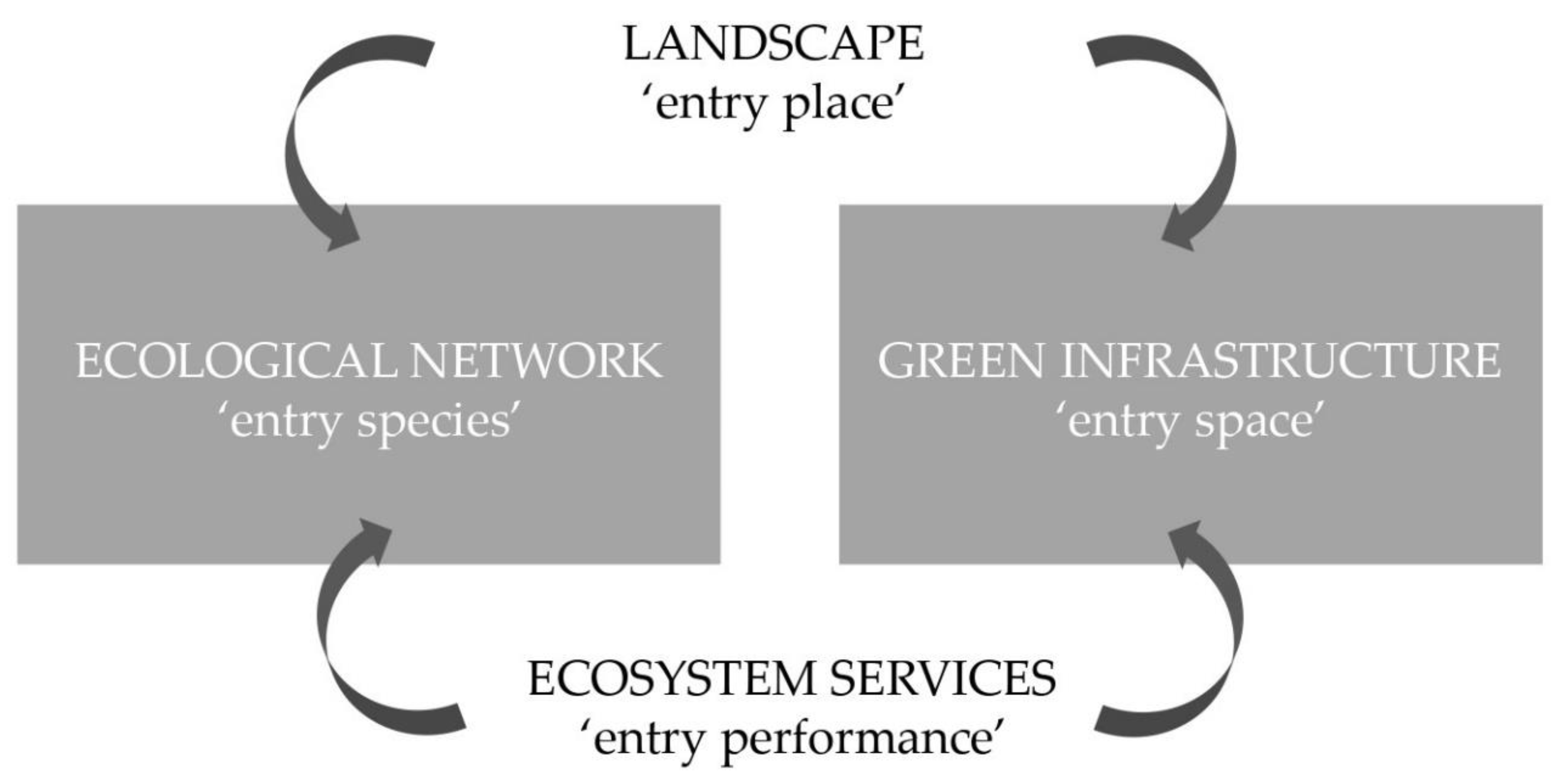
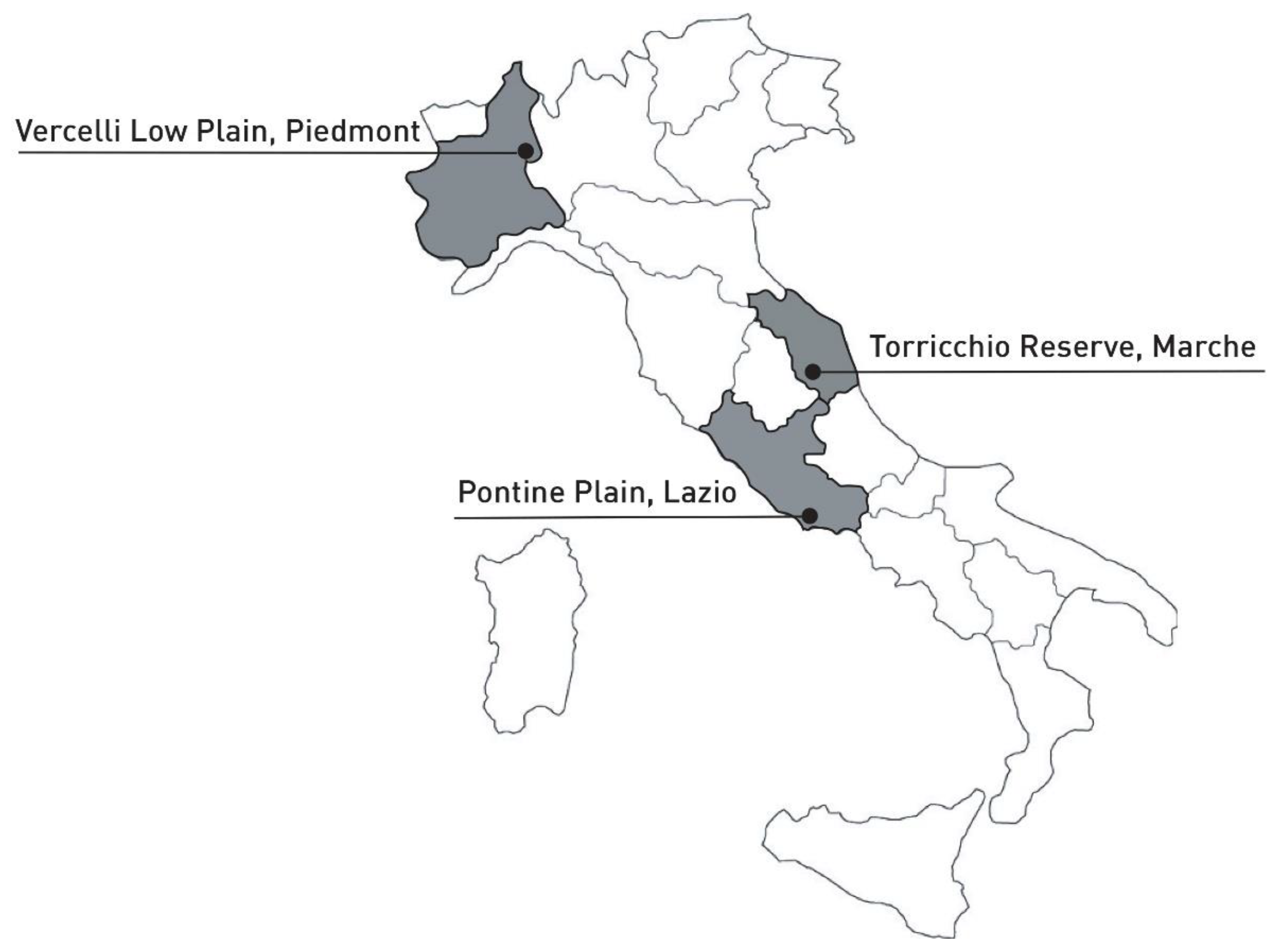
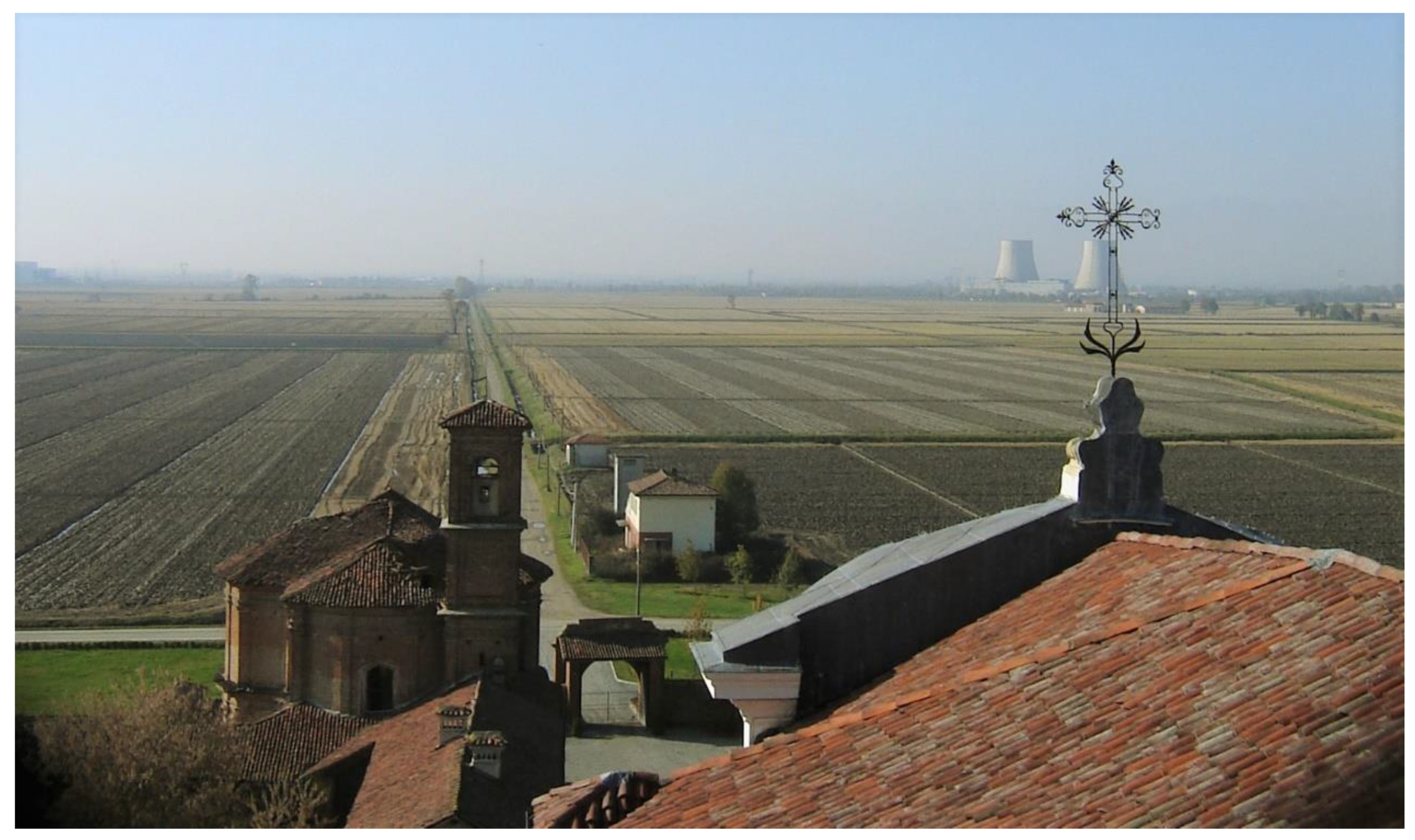
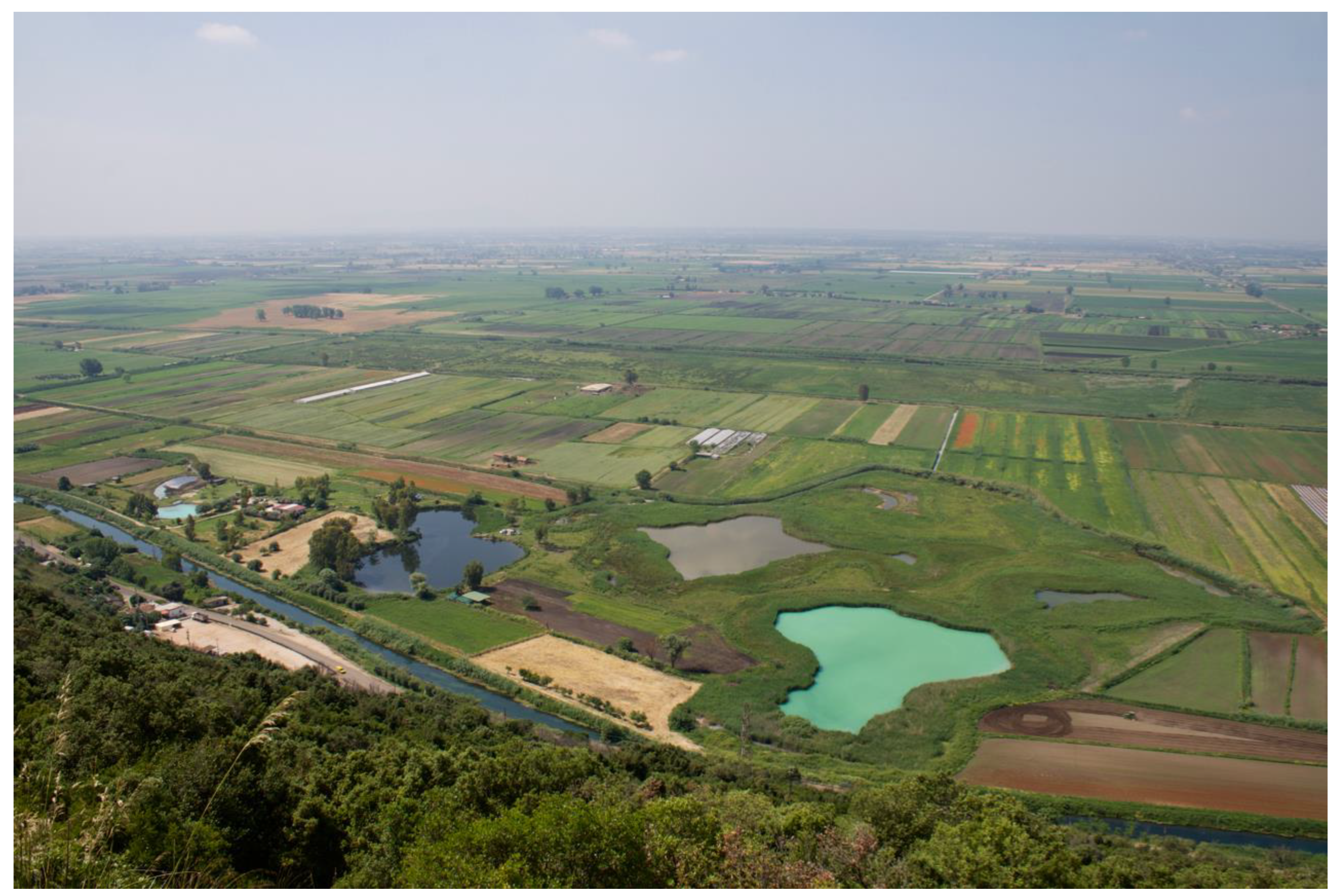
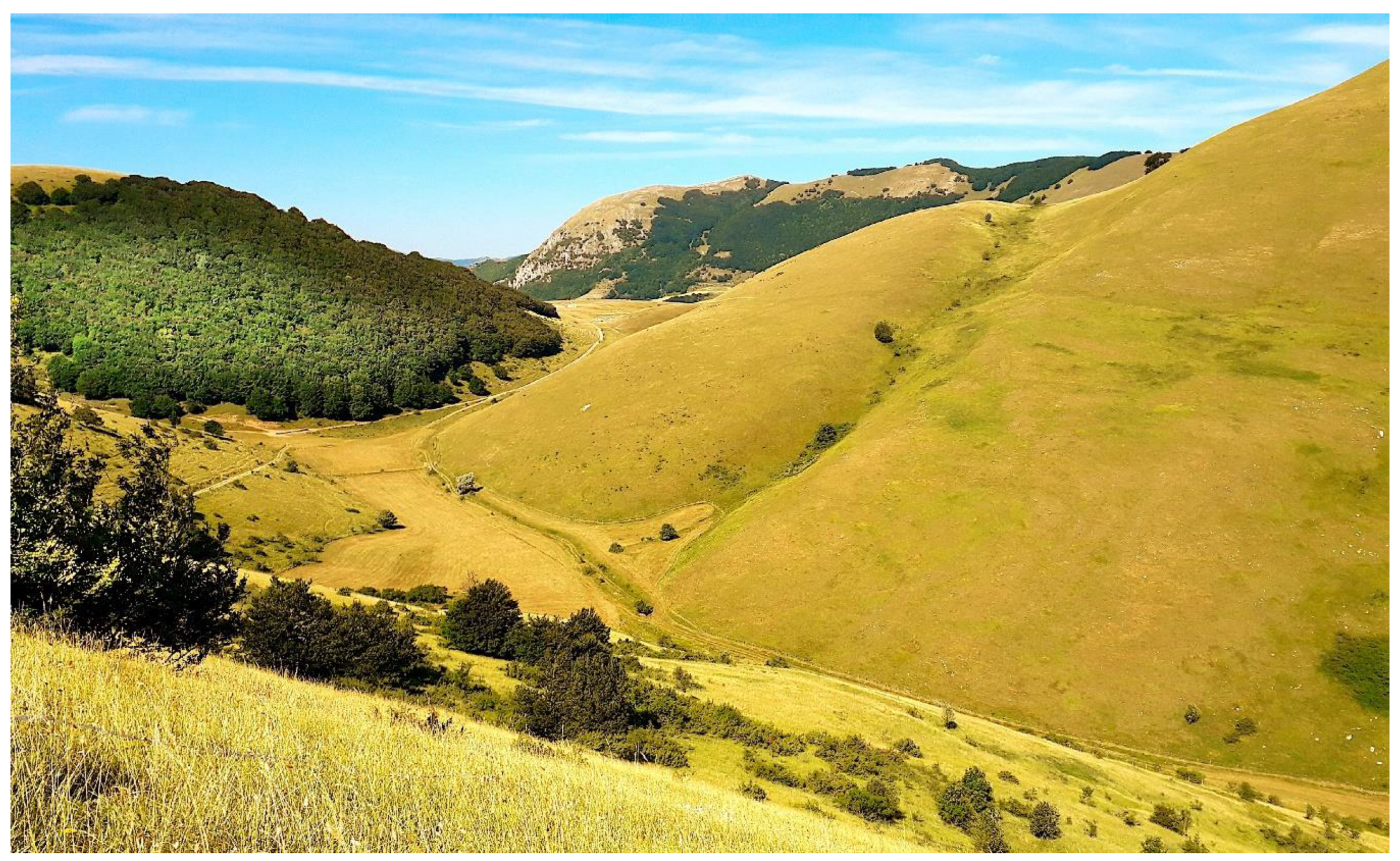
| Programming Period | Reform | Main Contents Related to Environmental Issues |
|---|---|---|
| 2000–2004 | Agenda 2000 | CAP reforms broke the link between direct payments and production. More emphasis was placed on the environment and animal welfare.
|
| 2005–20092010–2013 | Fischler Reform Health Check | Rural development plays an increasing role in setting CAP strategies, aligning with the EU’s structural policy. |
| 2014–2020 | Europa 2020 | The CAP budget is split into two headings (Pillar I and Pillar II) Pillar I Under the direct payment scheme, the greening payment is introduced as the second most important component after the basic payment, for an amount corresponding to 30% of the national ceiling, equal for all Member States. It is paid annually per eligible hectare. Farmers should comply with the following agricultural practices beneficial for the climate and the environment:
This accounts for 28% of the CAP budget, allowing for spatial allocation of expenditure within Rural Development Programmes (RDPs). The measures common to all regional programs are:
|
| Measures | Sub-Measures |
|---|---|
| Measure 4—Investment in physical assets | 4.3 Aid for investment in infrastructures tied to developing, modernizing, and adapting agriculture and forestry 4.4 Aid for non-productive investment in meeting agricultural, environmental, and climate targets |
| Measure 7—Basic services and village renewal in rural areas | 7.3 Aid for creating, improving, and expanding basic local services for the rural population, including recreational and cultural activities, and related infrastructure 7.4 Aid for investment in recreational infrastructure for public use, tourist information, and small-scale tourist infrastructure 7.5 Aid for studies/investments tied to maintaining, reclaiming and restoring the natural and cultural heritage of villages, rural landscapes, and areas with a high natural value, including their social and economic aspects, as well as ecological awareness-raising initiatives |
| Measure 10—Agri-environment and climate | 10.1 Aid for agri-environmental and climate commitments 10.2 Aid for the conservation, sustainable use, and development of genetic resources in agriculture |
| Measure 12—Payments under Natura 2000 and the Water Framework Directive | 12.1 Compensation payments for agricultural areas in the Natura 2000 Network 12.2 Compensation payments for forestry areas in the Natura 2000 Network 12.3 Compensation payments for agricultural areas included in basin hydrological plans |
| Measure 15—Forestry, environmental and climate services and forest conservation | 15.1 Payments for forestry, environmental, and climate commitments |
| Measure 16—Cooperation | 16.2 Aid for pilot projects and developing new products, practices. processes, and technologies 16.5 Aid for joint actions performed to mitigate climate change and adapt to it, and for joint approaches to environmental projects and existing environmental practices |
| Component | Description | |
|---|---|---|
| Core natural areas | Areas of high-quality habitats that are managed primarily for biodiversity conservation, whether or not they are protected. | 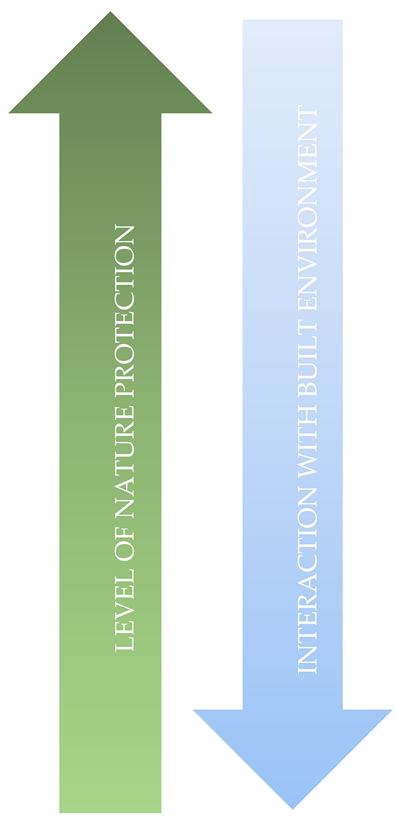 |
| Buffer zones | Transitional areas, located around highly natural areas where restrictions on resource use and special development measures are undertaken in order to enhance the conservation value of the protected area. | |
| Ecological corridors | Linear and continuous structures in the landscape varying in shape and size, connecting highly natural areas to each other and representing the key element of ecological networks since they allow for species mobility and genetic exchange, an indispensable phenomenon for maintaining biodiversity.These corridors form the “edges” in the network, linking core nature areas and stepping stones. | |
| Stepping stones | Smaller areas of quality habitats that are intended to help the movement of individuals by serving as islands of favorable habitats between larger core nature areas. These also represent “nodes” in the ecological network that, due to their strategic position or composition, may support species passing through a territory or host particular microenvironments in critical habitat situations. |
| Subject of Reforms | Intergovernmental Relationships | Internal Local Government |
|---|---|---|
| 1. Organizations | 1.1 Structural (i.e., change in number of Local Authorities, administrative boundaries) | 1.2 Organizational (i.e., changes in relations between political and administrative bodies) |
| 2. Decision-making | 2.1 Functional and procedural (i.e changes in the Administrations’ functions, procedures) | 2.2 Local programming (i.e, implementation/update of programming tools, plans) |
| 3. Financial resources | 3.1 Funding (i.e., change in EU, national, regional funding) | 3.2 Local funding (i.e., variation in fares regimes, local accounting regulations) |
| Target Area/Region | Promoter/Coordinator | Productive Features | Policy Process | Target Area Extension | CAP Payments |
|---|---|---|---|---|---|
| Vercelli lowlands plain, Piedmont | Province of Vercelli | Submerged rise cultivation | Wetland contract | 70,736 hectares | Pillar II |
| Pontine Plain, Lazio | Province of Latina | Intensive farming | Pact for Biodiversity | 77,000 hectares | Pillar I, II |
| Torricchio Reserve, Marche | Università di Camerino | Grazing | Agri-environmental Agreement | 1231 hectares | Pillar II |
| Stakeholders | Typology | Resources | Objectives | Role |
|---|---|---|---|---|
| Stakeholder 1 | Politician | Political | contents | Promoter & Director (policy entrepreneur) |
| Stakeholder 2 | Administrators | Financial | contents | Gatekeeper |
| Stakeholder 3 | Administrators | Legal | process | Allied |
| Stakeholder 4 | Special Interest | Knowledge | contents | Allied |
| Dimension of the Interest | Stakeholders Typology | ||||
|---|---|---|---|---|---|
| Politicians | Administrators | Experts | Special Interests | General Interests | |
| National | |||||
| Regional | |||||
| Local | |||||
| Stakeholder | Type | Resources | Objectives | Role |
|---|---|---|---|---|
| Vercelli Province | Politician | Political/legal | process/contents | Promoter & Director (policy entrepreneur) |
| Piedmont Region | Administrators | Political/legal/financial | process/contents | Ally |
| Po Basin Authority | General Interests | Legal | contents | Ally |
| Municipalities | Politician | Political/legal | contents | Ally |
| Park Authorities | Special Interests | Knowledge | contents | Ally |
| University | Experts | Knowledge | contents | Ally |
| Regional Agency for Environmental Protection | Experts | Knowledge | process/contents | Ally |
| Dimension of the Interest | Stakeholder Type | ||||
|---|---|---|---|---|---|
| Politicians | Administrators | Experts | Special Interests | General Interests | |
| National | University | Po Basin Authority | |||
| Regional | Piedmont Region | Regional Agency for Environmental Protection | |||
| Local | Province, Municipalities | Park Authorities | |||
| Stakeholder | Type | Resources | Objectives | Role |
|---|---|---|---|---|
| Province of Latina | Politician/Administrators | Political/legal | contents | Promoter & Director (policy entrepreneur) |
| Lazio Region | Politician/Administrators | Political/legal/financial | process/contents | Gatekeeper |
| Land Reclamation Association | Special Interest | Legal | contents | Ally |
| Municipalities | Politician/Administrators | Political/legal | contents | Ally |
| Park authorities | Special Interests | Knowledge | contents | Ally |
| Farmers associations | Special Interests | Political | contents | Ally |
| Research institutions | Experts | Knowledge | contents/process | Ally |
| Dimension of the Tnterest | Stakeholder Type | ||||
|---|---|---|---|---|---|
| Politicians | Administrators | Experts | Special Interests | General Interests | |
| National | Research institutions | ||||
| Regional | Lazio Region | ||||
| Local | Province of Latina, Municipalities | Park authorities, Farmers associations, Land Reclamation Association | |||
| Stakeholders | Type | Resources | Objectives | Role |
|---|---|---|---|---|
| UNICAM/Reserve Manager | Administrators | Legal/Knowledge | contents | Promoter & Director (policy entrepreneur) |
| Marche Region | Administrators | Legal/financial | process/contents | Gatekeeper |
| Municipalities/Mountain Communities | Politician/Administrators | Political/Legal | contents | Ally |
| NGOs | Special Interests | Knowledge | contents | Ally |
| Farmers | Special interests | Knowledge | contents | Ally |
| Farmers Associations | Special Interests | Political/Knowledge | contents | Ally |
| Dimension of the Interest | Stakeholder type | ||||
|---|---|---|---|---|---|
| Politicians | Administrators | Experts | Special Interests | General Interests | |
| National | NGOs | ||||
| Regional | Marche Region | UNICAM | Farmers associations | ||
| Local | Municipalities/Mountain Communities | UNICAM/Reserve Manager | Farmers | ||
© 2020 by the authors. Licensee MDPI, Basel, Switzerland. This article is an open access article distributed under the terms and conditions of the Creative Commons Attribution (CC BY) license (http://creativecommons.org/licenses/by/4.0/).
Share and Cite
Magaudda, S.; D’Ascanio, R.; Muccitelli, S.; Palazzo, A.L. ‘Greening’ Green Infrastructure. Good Italian Practices for Enhancing Green Infrastructure through the Common Agricultural Policy. Sustainability 2020, 12, 2301. https://doi.org/10.3390/su12062301
Magaudda S, D’Ascanio R, Muccitelli S, Palazzo AL. ‘Greening’ Green Infrastructure. Good Italian Practices for Enhancing Green Infrastructure through the Common Agricultural Policy. Sustainability. 2020; 12(6):2301. https://doi.org/10.3390/su12062301
Chicago/Turabian StyleMagaudda, Stefano, Romina D’Ascanio, Serena Muccitelli, and Anna Laura Palazzo. 2020. "‘Greening’ Green Infrastructure. Good Italian Practices for Enhancing Green Infrastructure through the Common Agricultural Policy" Sustainability 12, no. 6: 2301. https://doi.org/10.3390/su12062301
APA StyleMagaudda, S., D’Ascanio, R., Muccitelli, S., & Palazzo, A. L. (2020). ‘Greening’ Green Infrastructure. Good Italian Practices for Enhancing Green Infrastructure through the Common Agricultural Policy. Sustainability, 12(6), 2301. https://doi.org/10.3390/su12062301






